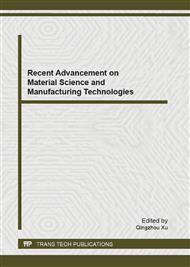p.324
p.328
p.332
p.337
p.342
p.346
p.350
p.357
p.363
Pure Al Coatings Prepared by Arc-Added Glow Plasma Depositing Technique and Subsequence Plasma Oxidation
Abstract:
Al coatings were prepared on 316L stainless steel substrate by arc-added glow plasma depositing technique and then plasma oxidized. The influences of bias voltage and arc source current on both the thickness and surface roughness of Al coatings were investigated respectively. Then, the microstructure and the composition of Al and Al2O3 coatings were characterized. Finally, the bonding force and the corrosion resistance of as-prepared alumina coatings were discussed. The results indicated that nanostructured pure Al coatings with surface roughness (Ra) of 267.93 nm were obtained when the bias of the substrate was-300V and the arc current was 70A. The Al2O3 coatings oxidized from nanoAl coatings were dense and uniform, with a bonding force of 37.4 N, an excellent corrosion potential of-0.202V and corrosion current of 0.197 μm·cm-2 in 3.5% NaCl solution.
Info:
Periodical:
Pages:
342-345
Citation:
Online since:
July 2013
Authors:
Price:
Сopyright:
© 2013 Trans Tech Publications Ltd. All Rights Reserved
Share:
Citation:


